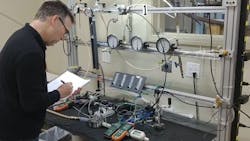Ventilator using Equilibar technology receives FDA emergency use authorization
June 9, 2020 (Equilibar release) — Equilibar, an engineering and manufacturing company in Fletcher, North Carolina, is pleased to announce that the U.S. Food and Drug Administration (FDA) has granted Emergency Use Authorization for the BioMedInnovations (BMI) SuppleVent. SuppleVent is a ventilator system that utilizes Equilibar patented back pressure regulator technology, licensed to BMI for medical devices.
Equilibar and BMI have a long-standing partnership developing precision air and fluid flow medical devices, with products-in-development for lung ventilators and ex vivo tissue perfusion. SuppleVent is the first FDA Emergency Use Authorization device to come out of this partnership. Other partners in the effort include Lawrence Livermore National Laboratory in California as well as several North Carolina-based motorsports companies.
The effort to design an alternative ventilator began as a way to address the increased need for life-saving healthcare equipment for people experiencing Acute Respiratory Distress Syndrome and other serious breathing difficulties due to the COVID-19 pandemic.
“On March 20, Equilibar received an inquiry about using our back pressure regulators as a building block for alternative ventilator designs that bypass traditional supply chains,” said Jeff Jennings, Equilibar president. “Similar requests followed as hospitals around the world began to plan for an increased need for ventilators. Our technical team immediately started modifying several of the components, often working nights and weekends. It was amazing to work with both BMI and Lawrence Livermore to perfect the design.”
Further collaboration came when BMI made connections with Roush Yates Manufacturing Solutions, a division of Roush Yates Engines, and Joe Gibbs Racing to build components for the ventilator. Indy Car engine designer, Honda Performance Development, also assisted with testing and engineering. The manufacturing capabilities of the motorsports companies will ensure that the devices can be produced quickly and in volume.
“The innovation that I’ve witnessed during the past two months has been breath-taking,” Jennings said. “Our team has had the chance to work with world class scientists at one of the nation’s premier laboratories as well as with the truly visionary team at BMI. To be able to partner with legendary North Carolina motorsports companies on top of that has been an experience I won’t forget.”
The SuppleVent is a simple assembly of components with an intuitive and clinician-friendly interface that includes full alarms and low power operation from a compressed gas source. Forward flexibility is included in the system architecture to add additional displays, data logging, wireless communication, closed loop control and other features, if desired. The design prevents high pressures that can damage the lung and can be used in mobile settings.
